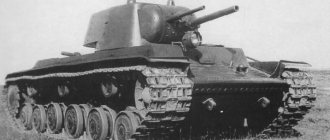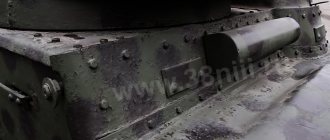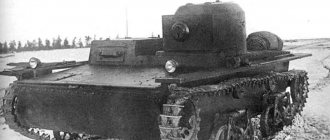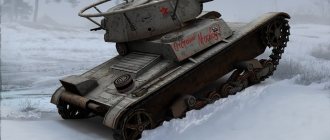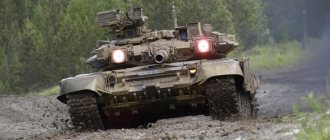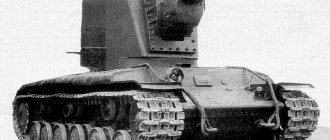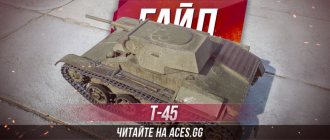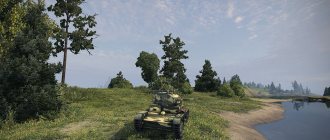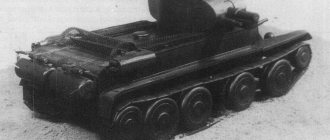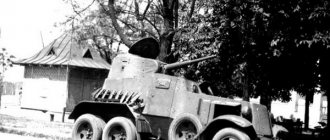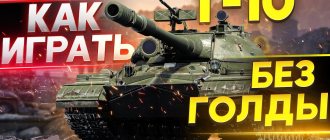| KV-1 | |
| KV-1 arr. 1940 | |
| Classification: | heavy tank |
| Combat weight, t: | 43,1 |
| Layout diagram: | Classical |
| Crew, persons: | 5 |
| Story | |
| Years of production: | 1940—1942 |
| Years of operation: | 1940—1944 |
| Number of issued, pcs.: | 2769 |
| Main operators: | Union of Soviet Socialist Republics |
| Dimensions | |
| Case length, mm: | 6675 |
| Case width, mm: | 3320 |
| Height, mm: | 2710 |
| Ground clearance, mm: | 450 |
| Booking | |
| Armor type: | Rolled steel homogeneous |
| Body forehead (top), mm/deg.: | 75 / 30° |
| Body forehead (middle), mm/deg.: | 40 / 65° |
| Body forehead (bottom), mm/deg. | 75 / 30° |
| Hull side, mm/deg.: | 75 / 0° |
| Hull stern (top), mm/deg.: | 60 / 50° |
| Hull rear (bottom), mm/deg.: | 70 / 0—90° |
| Bottom, mm: | 30—40 |
| Housing roof, mm: | 30—40 |
| Turret front, mm/deg.: | 75 / 20° |
| Gun mask, mm/deg.: | 90 |
| Tower side, mm/deg.: | 75 / 15° |
| Tower feed, mm/deg.: | 75 / 15° |
| Tower roof, mm: | 40 |
| Armament | |
| Caliber and brand of gun: | 76 mm L-11, F-32, F-34, ZIS-5 |
| Gun type: | Rifled |
| Barrel length, calibers: | 30,5 |
| Gun ammunition: | 90 or 114 (depending on version) |
| Angles VN, degrees: | −7…+25° |
| Sights: | Telescopic TOD-6, periscopic PT-6 |
| Machine guns: | 3 × DT |
| Mobility | |
| Engine's type: | V-shaped 12-cylinder four-stroke diesel liquid cooled |
| Engine power, l. With: | 500 |
| Highway speed, km/h: | 34 |
| Cruising range on the highway, km: | 150—225 |
| Cruising range over rough terrain, km: | 90—180 |
| Specific power, l. s./t: | 11,6 |
| Suspension type: | Individual torsion bar |
| Specific ground pressure, kg/cm²: | 0,77 |
KV-1 (Klim Voroshilov) - Soviet heavy tank from the Second World War. Usually called simply “KV”: the tank was created under this name and only later, after the appearance of the KV-2 tank, the KV of the first model was retrospectively given a digital index. Produced from March 1940 to August 1942. He took part in the war with Finland and the Great Patriotic War.
History of the KV-1
The need to create a heavy tank carrying projectile-proof armor was understood only in the USSR. According to Russian military theory, such tanks were necessary to break into the enemy’s front and organize a breakthrough or overcome fortified areas. In fact, not a single army in the world (except the USSR) had either the theory or practice of overcoming powerful fortified enemy positions. Such fortified lines as, for example, the Maginot Line or the Mannerheim Line were considered even theoretically insurmountable. There is a misconception that the tank was created during the Finnish campaign to break through Finnish long-term fortifications (the Mannerheim Line). In fact, the tank began to be designed at the end of 1938, when it finally became clear that the concept of a multi-turreted heavy tank like the T-35 was a dead end. It was obvious that having a large number of towers was not an advantage. And the gigantic dimensions of the tank only make it heavier and do not allow the use of thick enough armor. The initiator of the creation of the tank was the head of the ABTU of the Red Army, corps commander D. G. Pavlov.
At the end of the 1930s, attempts were made to develop a tank of reduced size (compared to the T-35), but with thicker armor. However, the designers did not dare to abandon the use of several towers: it was believed that one gun would fight infantry and suppress firing points, and the second must be anti-tank - to combat armored vehicles.
The new tanks created within the framework of this concept (SMK and T-100) had two turrets, armed with 76 mm and 45 mm guns. And only as an experiment, they also developed a smaller version of the QMS - with one tower. Due to this, the length of the vehicle was reduced (by two road wheels), which had a positive effect on the dynamic characteristics. Unlike its predecessor, the KV (as the experimental tank was called) received a diesel engine. The first copy of the tank was manufactured at the Leningrad Kirov Plant (LKZ) in August 1939. Initially, the leading designer of the tank was A. S. Ermolaev, then N. L. Dukhov.
On November 30, 1939, the Soviet-Finnish War began. The military did not miss the opportunity to test new heavy tanks. The day before the start of the war (November 29, 1939), the SMK, T-100 and KV went to the front. They were transferred to the 20th Heavy Tank Brigade, equipped with T-28 medium tanks.
The KV took on its first battle on December 17 during the breakthrough of the Khottinensky fortified area of the Mannerheim Line.
KV crew in the first battle:
- Lieutenant Kachekhin (commander)
- I. Golovachev military technician 2nd rank (driver mechanic)
- Lieutenant Polyakov (gunner)
- K. Kovsh (driver mechanic, tester at the Kirov plant)
- A. I. Estratov (motor operator/loader, tester at the Kirov plant)
- P. I. Vasiliev (transmission operator/radio operator, tester at the Kirov plant)
The tank successfully passed combat tests: not a single enemy anti-tank gun could hit it. The only thing that upset the military was that the 76-mm L-11 gun was not strong enough to fight the bunkers. For this purpose, it was necessary to create a new KV-2 tank, armed with a 152 mm howitzer.
According to the proposal of the GABTU, by a joint resolution of the Politburo of the Central Committee of the All-Union Communist Party of Bolsheviks and the Council of People's Commissars of the USSR dated December 19, 1939 (the very day after the tests), the KV tank was adopted for service. As for the SMK and T-100 tanks, they also showed themselves in a rather favorable light (however, the SMK was blown up by a mine at the beginning of hostilities), but were not accepted for service, since with higher firepower they carried less thick armor , had larger sizes and weight, as well as worse dynamic characteristics.
Serial production of KV tanks began in February 1940 at the Kirov plant. In accordance with the resolution of the Council of People's Commissars of the USSR and the Central Committee of the All-Union Communist Party of Bolsheviks dated June 19, 1940, the Chelyabinsk Tractor Plant (ChTZ) was also ordered to begin production of HF. On December 31, 1940, the first KV was assembled at ChTZ. At the same time, the plant began construction of a special building for the assembly of HF.
For 1941, it was planned to produce 1,200 KV tanks of all modifications. Of these, 1000 pieces are at the Kirov plant. (400 KV-1, 100 KV-2, 500 KV-3) and another 200 KV-1 at ChTZ. However, only a few tanks were assembled at ChTZ before the start of the war. A total of 243 KV-1 and KV-2 were built in 1940, and 393 in the first half of 1941.
After the start of the war and the mobilization of industry, the production of tanks at the Kirov plant increased significantly. The production of KV tanks was given priority, so the Leningrad Izhora and Metal plants, as well as other plants, joined in the production of many components and assemblies for heavy tanks.
However, starting from July 1941, the evacuation of the LKZ to Chelyabinsk began. The plant is located on the territory of the Chelyabinsk Tractor Plant. On October 6, 1941, the Chelyabinsk Tractor Plant was renamed the Chelyabinsk Kirov Plant of the People's Commissariat of Tank Industry. This plant, which received the unofficial name "Tankograd", became the main manufacturer of heavy tanks and self-propelled guns during the Great Patriotic War.
Despite the difficulties associated with the evacuation and deployment of the plant in a new location, in the second half of 1941 the front received 933 KV tanks; in 1942, 2,553 of them were built (including the KV-1s).
In August 1942, the KV-1 was discontinued and replaced by a modernized version, the KV-1s. One of the reasons for the modernization was, oddly enough, the powerful armor of the tank. A total of 2,769 KV-1 tanks were produced.
To be a heavy tank
The second half of the 30s was a period when the world and, especially Europe, lived in anticipation of war. Countries responded differently to the difficult political environment. The role of armored forces in the future confrontation was ambiguously assessed.
The French and Italians viewed them as a means of supporting infantry and cavalry, giving them a supporting role. The British established the need to have two types of tanks: cruising and infantry, which performed different functions.
The Germans considered the use of tanks as part of large formations, which, with the support of aviation, should break through the defenses and move forward without waiting for the infantry.
The concept of Soviet military specialists provided for the use of all types of tanks to break through tactical defenses, to support infantry and develop success in the operational space, operating as part of tank and mechanized formations. But if the issues of improving light and medium vehicles in the pre-war period were resolved well, then the situation with heavy ones was worse.
The next attempts to create a heavy tank boiled down to strengthening the armor protection (as a consequence - increasing the mass of the tank) and using the common multi-turreted version (increasing dimensions), to the detriment of speed and maneuverability. Such vehicles and armor protection were lost. Fortunately, after the production of 59 units of the T-35 tank and its recognition as unpromising, work on creating heavy tanks went in a different direction.
In the history of the creation of a heavy tank, 1939 turned out to be the most successful:
- in February, the Leningrad Kirov Plant (LKZ) began development of the KV tank, named after the People's Commissar of Defense of the USSR, Kliment Efremovich Voroshilov;
- by the end of the year, the 185th plant completed the development of the 58-ton double-turret T-100 tank;
- another version of the heavy tank was the 55-ton model, also developed at LKZ and named after Sergei Mironovich Kirov - SMK;
- shortly after the outbreak of the Soviet-Finnish war in November 1939, all three samples were sent for testing to the combat area. The victory in this “competition” was won by the KV heavy tank, with one significant caveat. The military who conducted the test were not satisfied with the weak 76 mm gun for such a powerful tank;
- The decision was made to serially produce the KV tank.
Tank design
For 1940, the production KV-1 was a truly innovative design that embodied the most advanced ideas of the time: an individual torsion bar suspension, reliable ballistic armor, a diesel engine and one powerful universal weapon within the framework of a classic layout. Although individual solutions from this set had been repeatedly implemented previously on other foreign and domestic tanks, the KV-1 was the first combat vehicle to embody their combination. Some experts consider it as a landmark vehicle in world tank construction, which had a significant influence on the development of subsequent heavy tanks in other countries. The classic layout on a serial Soviet heavy tank was used for the first time, which allowed the KV-1 to obtain the highest level of security and great modernization potential within the framework of this concept compared to the previous production model of the T-35 heavy tank and the experimental SMK and T-100 vehicles (all - multi-tower type). The basis of the classic layout is the division of the armored hull from bow to stern, successively into a control compartment, a fighting compartment and an engine-transmission compartment. The driver and gunner-radio operator were located in the control compartment, three other crew members had jobs in the fighting compartment, which combined the middle part of the armored hull and the turret. The gun, its ammunition and part of the fuel tanks were also located there. The engine and transmission were installed at the rear of the vehicle.
Armored hull and turret
The armored body of the tank was welded from rolled armor plates with a thickness of 75, 40, 30 and 20 mm. The armor protection is equally strong (armor plates with a thickness other than 75 mm were used only for horizontal armoring of the vehicle), and is projectile-resistant. The armor plates of the frontal part of the vehicle were installed at rational angles of inclination. The serial HF turret was produced in three versions: cast, welded with a rectangular niche, and welded with a rounded niche. The thickness of the armor for welded turrets was 75 mm, for cast ones - 95 mm, since cast armor was less durable. In 1941, the welded turrets and side armor plates of some tanks were further strengthened - 25-mm armor screens were bolted onto them, and an air gap remained between the main armor and the screen, that is, this version of the KV-1 actually received spaced armor. It is not entirely clear why this was done. The Germans began to develop heavy tanks only in 1941 (the heavy tank was not used in the German blitzkrieg theory), so for 1941 even the standard armor of the KV-1 was, in principle, redundant. Some sources erroneously indicate that the tanks were produced with rolled armor 100 mm thick or more - in fact, this figure corresponds to the sum of the thickness of the main armor of the tank and the screens.
The front part of the turret with the embrasure for the gun, formed by the intersection of four spheres, was cast separately and welded with the rest of the armored parts of the turret. The gun mantlet was a cylindrical segment of bent rolled armor plate and had three holes - for a cannon, a coaxial machine gun and a sight. The turret was mounted on a shoulder strap with a diameter of 1535 mm in the armored roof of the fighting compartment and was secured with grips to prevent stalling in case of a strong roll or overturning of the tank. The turret shoulder straps were marked in thousandths for firing from closed positions.
The driver was located in the center in the front part of the armored hull of the tank, to the left of him was the radio operator's workplace. Three crew members were located in the turret: to the left of the gun were the workstations of the gunner and loader, and to the right was the tank commander. The crew entered and exited through two round hatches: one in the turret above the commander’s workplace and one on the roof of the hull above the gunner-radio operator’s workplace. The hull also had a bottom hatch for emergency escape by the crew of the tank and a number of hatches, hatches and technological openings for loading ammunition, access to the necks of fuel tanks, and other components and assemblies of the vehicle.
Armament
The first production tanks were equipped with a 76.2 mm L-11 cannon with 111 rounds of ammunition (according to other sources - 135). It is interesting that the original project also included a coaxial 45-mm 20K cannon, although the armor penetration of the 76-mm L-11 tank gun was practically not inferior to the 20K anti-tank gun. Apparently, strong stereotypes about the need to have a 45-mm anti-tank gun along with a 76-mm were explained by its higher rate of fire and larger ammunition load. But already on the prototype, aimed at the Karelian Isthmus, the 45-mm cannon was removed and a DT-29 machine gun was installed instead. Subsequently, the L-11 gun was replaced by a 76-mm F-32 gun, and in the fall of 1941 - by a ZIS-5 gun with a longer barrel of 41.6 calibers.
The ZIS-5 gun was mounted on axles in the turret and was completely balanced. The turret itself with the ZIS-5 gun was also balanced: its center of mass was located on the geometric axis of rotation. The ZIS-5 gun had vertical aiming angles from −5 to +25°; with a fixed turret position, it could be aimed in a small sector of horizontal aiming (the so-called “jewelry” aiming). The shot was fired using a manual mechanical trigger.
The gun's ammunition capacity was 111 rounds of unitary loading. The shots were placed in the turret and along both sides of the fighting compartment.
The KV-1 tank was equipped with three 7.62-mm DT-29 machine guns: coaxial with a gun, as well as a forward and aft one in ball mounts. The ammunition load for all diesel engines was 2772 rounds. These machine guns were mounted in such a way that, if necessary, they could be removed from the mounts and used outside the tank. Also, for self-defense, the crew had several F-1 hand grenades and was sometimes equipped with a pistol for firing flares. Every fifth KV was equipped with an anti-aircraft turret for DT, but in practice anti-aircraft machine guns were rarely installed.
Engine
The KV-1 was equipped with a four-stroke V-shaped 12-cylinder diesel engine V-2K with a power of 500 hp. With. (382 kW) at 1800 rpm, subsequently, due to the general increase in the mass of the tank after installing heavier cast turrets, screens and eliminating the shavings of the edges of the armor plates, the engine power was increased to 600 hp. With. (441 kW). Starting the engine was ensured by an ST-700 starter with a power of 15 hp. With. (11 kW) or compressed air from two 5-liter tanks in the fighting compartment of the vehicle. The KV-1 had a dense layout, in which the main fuel tanks with a volume of 600-615 liters were located in both the combat and engine compartments. In the second half of 1941, due to a shortage of V-2K diesel engines, which were then produced only at plant No. 75 in Kharkov (in the fall of that year, the process of evacuating the plant to the Urals began), KV-1 tanks were produced with four-stroke V-shaped 12- M-17T cylinder carburetor engines with a power of 500 hp. With. In the spring of 1942, a decree was issued to convert all KV-1 tanks in service with M-17T engines back to V-2K diesel engines - the evacuated plant No. 75 established their production in sufficient quantities at the new location.
Transmission
The KV-1s tank was equipped with a mechanical transmission, which included:
- multi-disc main clutch of dry friction “steel on ferodo”;
- five-speed tractor-type gearbox;
- two multi-disc side clutches with steel-on-steel friction;
- two onboard planetary gearboxes;
- band floating brakes.
All transmission control drives are mechanical. When used by the troops, the greatest number of complaints and complaints to the manufacturer were caused by defects and extremely unreliable operation of the transmission group, especially in overloaded wartime KV tanks. Almost all authoritative printed sources recognize that one of the most significant shortcomings of the KV series tanks and vehicles based on it is the low reliability of the transmission as a whole.
Chassis
The vehicle's suspension is individual torsion bar with internal shock absorption for each of the 6 stamped gable road wheels of small diameter on each side. Opposite each road wheel, travel limiters of the suspension balancers were welded to the armored body. The drive wheels with removable pinion gears were located at the rear, and the idlers were located at the front. The upper branch of the caterpillar was supported by three small rubberized stamped support rollers on each side. In 1941, the technology for manufacturing support and support rollers was transferred to casting; the latter lost rubber tires due to the general shortage of rubber at that time. The caterpillar tension mechanism is screw; each caterpillar consisted of 86-90 single-ridge tracks with a width of 700 mm and a pitch of 160 mm.
Electrical equipment
The electrical wiring in the KV-1 tank was single-wire, the second wire being the armored hull of the vehicle. The exception was the emergency lighting circuit, which was two-wire. The sources of electricity (operating voltage 24 V) were a GT-4563A generator with a RPA-24 relay-regulator with a power of 1 kW and four series-connected 6-STE-128 batteries with a total capacity of 256 Ah. Electricity consumers included:
- turret rotation electric motor;
- external and internal lighting of the vehicle, illumination devices for sights and scales of measuring instruments;
- external sound signal and signaling circuit from the landing force to the vehicle crew;
- instrumentation (ammeter and voltmeter);
- means of communication - radio station and tank intercom;
- electrician of the motor group - starter ST-700, starting relay RS-371 or RS-400, etc.
Surveillance equipment and sights
The general visibility of the KV-1 tank back in 1940 was assessed in a memo to L. Mehlis from military engineer Kalivoda as extremely unsatisfactory. The vehicle commander had the only viewing device in the turret - the PTK panorama. In combat, the driver conducted observation through a viewing device with a triplex, which was protected by an armored flap. This viewing device was installed in an armored hatch on the front armor plate along the longitudinal center line of the vehicle. In a quiet environment, this plug hatch could be pulled forward, providing the driver with a more convenient direct view from his workplace.
For firing, the KV-1 was equipped with two gun sights - the telescopic TOD-6 for direct fire and the periscopic PT-6 for firing from closed positions. The head of the periscope sight was protected by a special armored cap. To ensure the possibility of fire in the dark, the sight scales had illumination devices. The forward and stern DT machine guns could be equipped with a PU sight from a sniper rifle with a threefold magnification.
Means of communication
Communications included the radio station 71-TK-3, later 10R or 10RK-26. Due to shortages, a number of tanks were equipped with 9P aviation radios. The KV-1 tank was equipped with an internal intercom TPU-4-Bis for 4 subscribers.
Radio stations 10Р or 10РК were a set of a transmitter, receiver and umformers (single-armature motor-generators) for their power supply, connected to an on-board 24 V power supply.
10P was a simplex tube shortwave radio station operating in the frequency range from 3.75 to 6 MHz (wavelengths from 80 to 50 m, respectively). When parked, the communication range in telephone (voice) mode reached 20-25 km, while on the move it decreased somewhat. A greater communication range could be obtained in telegraph mode, when information was transmitted by a telegraph key using Morse code or another discrete coding system. Frequency stabilization was carried out by a removable quartz resonator; there was no smooth frequency adjustment. 10P allowed communication on two fixed frequencies; to change them, another quartz resonator of 15 pairs included in the radio set was used.
The 10RK radio station was a technological improvement of the previous 10P model; it became simpler and cheaper to produce. This model now has the ability to smoothly select the operating frequency; the number of quartz resonators has been reduced to 16. The communication range characteristics have not undergone significant changes.
The TPU-4-Bis tank intercom made it possible to negotiate between members of the tank crew even in a very noisy environment and connect a headset (headphones and laryngophones) to a radio station for external communication.
Howitzer KV
The so-called artillery tanks, or support tanks, first appeared in the mid-20s.
The pioneers here were the British, who armed some of their Medium Tank Mk.I and Medium Tank Mk.II with 94 mm howitzers.
Later, similar machines were built in different countries. The Soviet Union was no exception. The first developments in artillery tanks in the USSR date back to the early 30s; the most famous vehicle of this type was the BT-7 Artillery. With some degree of convention, the KV-2 can also be classified as an artillery tank. However, even before the start of the Great Patriotic War, the idea of artillery tanks was rejected in the USSR. Nevertheless, already at the beginning of 1942, the KV-9 , which fully corresponded to the concept of a “support tank”.
Child of artillery famine
The history of the appearance of the KV-9 is usually described based on a report from Uralmash (Ural Heavy Engineering Plant, UZTM) on tank building during the war years. According to him, the design of the 122 mm caliber system “was carried out on a proactive basis and was aimed at creating more powerful guns for the tank than the L-11 F-34 that our tanks were armed with at that time.”
. Additionally, some domestic historians added fuel to the fire, claiming that the design of a 122 mm tank howitzer began back in 1939, and the second attempt - in the spring of 1941.
In fact, in 1939, and even more so in the spring of 1941, there was no interest in the M-30 howitzer as a tank weapon. At that time, the leadership of the Main Armored Directorate of the Red Army (GABTU KA) showed interest not in the increased high-explosive effect, but in increased armor penetration. The M-30 howitzer did not do well with this, especially considering the lack of armor-piercing shells. It is not surprising that this howitzer was not considered at all as a tank weapon.
Production of M-30 howitzers at UZTM. The established production of this weapon directly influenced the choice of an alternative weapon system for the KV-1
The summary report of the Uralmashplant on tank building during the war period is considered by many to be the main and completely reliable source of information. In fact, this is quite reckless. It was created in 1945, and over the years, as well as due to the confusion of wartime, a number of points in the report were distorted. Suffice it to say that this document did not include a number of vehicles designed at Uralmash, mainly self-propelled units.
And in the case of the KV-9, this same distortion occurred. How inconsistent the report is with the real picture can be understood from the journal of the Artillery Committee of the Main Artillery Directorate of the Red Army (GAU KA), dedicated to testing a 122-mm howitzer in the KV-9:
“In the autumn of 1941, when the production of KV tanks was being launched at Ural enterprises, the question arose about the insufficient provision of artillery weapons for tanks. The production of F-32 guns at the Kirov plant in Leningrad, due to the conditions of the moment, was curtailed, and the only manufacturer of tank guns was plant No. 92 named after. Stalin in Gorky, which mainly produced the F-34 cannon for T-34 tanks, and only in October began to develop production of 76 mm tank guns mod. 1941 (ZIS-5) with a forty-caliber barrel.
To ensure the armament of KV tanks, it became necessary to prepare the production of tank guns somewhere close to the center of tank production. In solving this problem, it was necessary, first of all, to take into account the production capabilities of local factories and the nature of the weapons production established at them, since it was necessary to ensure the minimum time for the deployment of gun production.
Based on these considerations, the technical council of the NKTP issued an order to the design bureau of Uralmashzavod, which was then one of the NKTP enterprises, to develop a technical design and manufacture a prototype installation of a 122 mm howitzer mod. 1938 (M-30) into the KV tank."
As you can see, there is not a single word in the text about increasing the firepower of a tank gun. An excerpt from the journal of the Artillery Committee of the GAU KA roughly corresponds to what actually happened. The first 17 ZIS-5 guns arrived at the Chelyabinsk Tractor Plant (ChTZ) at the very end of September 1941, and full production began in October. In September, ChTZ delivered only 27 tanks instead of 65, and instead of 100, 87 vehicles were built in Chelyabinsk in October. Naturally, the guns were not the only bottleneck: there were problems with the supply of V-2K engines, and a large percentage of defects were observed in the production of gears. Part of the responsibility for the failure to fulfill the plan lay with Uralmash: the report for October indicated that the plant had disrupted the plan for the production of armored systems.
Problems with engines, which were quite obvious due to the evacuation of plant No. 75, were partially solved by organizing the production of engines of the V-2 family at the site of the Ural Turbine Plant. On December 13, Plant No. 76 was created on this base, and the first B-2Ks arrived from here back in November. In the Urals, its own full-cycle tank production was formed.
U-11 system, drawing dated December 15, 1941
Where did the M-30 howitzer come from as an alternative to the ZIS-5? The answer to this question directly follows from the requirement to make maximum use of the production capabilities of local factories. In 1940, Uralmash mastered the production of those same M-30s. To ensure production, F.F. arrived from Molotov (now Perm). Petrov, chief designer of the gun. As a result, Petrov remained at Uralmash, taking a leadership position in the plant design bureau. Thus, there were simply no alternatives other than the M-30 as a replacement for the ZIS-5. The myth about increasing firepower arose against the background of the emergence of another project - the U-12. It was created on the basis of the 85-mm anti-aircraft gun 52-K, the production of which was evacuated from Kaliningrad near Moscow (now the city of Korolev) to Sverdlovsk along with the design bureau of plant No. 8.
Emergency option
According to the historical information of the Arktom GAU, the project for the gun mount was prepared by the 20th of November 1941. The design was supervised by the chief designer of the factory design bureau F.F. Petrov, with L.I. acting as his deputy. Gorlitsky, evacuated from Leningrad in October 1941. These two men later became key figures in the design of Soviet medium self-propelled artillery. The leading engineer of the project was V.N. Sidorenko, one of the veterans of Uralmash artillery production. Engineers A.V. also worked on the new system. Usenko and N.V. Kurin, the latter also arrived from Leningrad. The project was supervised by Zh.Ya. Kotin. In addition to working on the general management of the HF topic, Joseph Yakovlevich by that time was the Deputy People's Commissar of the tank industry.
Division of production areas of UZTM, during which plant No. 8 was separated into a separate enterprise. The launch of the production of the ZIS-5 tank gun on its premises finally put an end to truly mass production of the U-11
The project presented at the meeting with Kotin existed in two versions. The first version of the system, designated U-11, featured minimal interference in the design of the swinging part of the M-30 howitzer. Unfortunately, no images of this version have survived, but in general it resembled what was supposed to be installed in the ZIK-11 and SG-122 self-propelled guns. Instead of a stand, the swinging part of the howitzer was placed in a frame and covered with armor. This option seemed simpler from a production point of view, but was completely unsuitable for use as a tank gun. Firstly, the system had a very complex and cumbersome armor. Secondly, the overall layout of the tower was disrupted, as well as its balance. It is not surprising that such a system was abandoned.
The second version of the U-11 was more complex from a production point of view. The barrel and breech remained from the M-30, while the pipe was also redone, and the recoil devices were made from scratch. However, from a production point of view, everything was not as scary as it might seem. The overall design of the system looked quite simple, and the newly manufactured components turned out to be maximally adapted to the technical conditions of the plant. The most important thing is that no significant modification of the KV turret was required.
KV-9 in the factory workshop, January 1942
As a result of the meeting, a much more compact second option, much better suited for the role of a tank gun, was adopted:
“The technical meeting made a decision, which was briefly summarized as follows. Based on this version of the preliminary design (it was prescribed - editor's note), the design bureau of Uralmashzavod developed a technical design for the installation and manufactured one prototype of it. At the same time, taking into account the absence of an armor-piercing projectile, the bulkiness of the ammunition and its limitations, a strong decrease in the rate of fire and other negative circumstances, the technical meeting specifically repeated that it considers this work as an emergency portfolio option.”
It is easy to notice the attitude towards the project on the part of the GAU KA. It was due to the fact that the peak of the “gun famine” had passed. Moreover, after the evacuation of plant No. 8 to Sverdlovsk, it was decided that ZIS-5 guns would be produced not only in Gorky, but also at the UZTM site. This decision was finally approved by State Defense Committee Resolution No. 1070ss “On the construction of plant No. 8 NKV.” The deployment of guns for the KV-1 was somewhat delayed, but already in January 1942, Chelyabinsk tanks began to receive Sverdlovsk guns. Against this background, the new weapon, inferior in rate of fire, with vague prospects for penetration and requiring some modification of the turret, looked less attractive.
The same tank from the front
Despite such bleak conclusions of the meeting, the U-11 project has progressed much further than preliminary studies. By December 15, 1941, the technical documentation was ready. Designer A.S. was involved in the work from ChTZ. Shneidman, who oversaw the issue of arming the heavy tank. The system fit perfectly into the KV-1 turret, although it was necessary to slightly change the embrasure, gun mantlet, installation of viewing devices and make a new movable armor. According to the project, the declination angle of the U-11 was −3.5 degrees; recoil mechanisms did not allow it to be made large.
KV-9, left view
Towards the end of December 1941, the U-11 prototype was manufactured in metal and passed factory tests on a bench installation. A little later, the reservation details were ready, after which the system went to Chelyabinsk to ChKZ. To install a prototype gun, instead of a new tank, it was decided to use the KV-1 tank No. 4996, which had undergone a major overhaul, produced in Leningrad. Judging by the papers, this tank, before it ended up in Chelyabinsk, managed to fight as part of the 121st Tank Brigade. The U-11 was installed in a cast turret while retaining the rear machine gun. In general, the gun fit perfectly into the turret, but the declination angle turned out to be even less than the design one, amounting to −2 degrees. Initially it was assumed that the ammunition load would be about 50 rounds, but in the end it turned out to be slightly less - 48 rounds. For comparison, the standard ammunition load of the ZIS-5 gun was 114 rounds. There was also less ammunition for the machine gun - 1943 pieces instead of 3000. The converted vehicle received the designation KV-9.
False start
In general, the attitude towards the KV-9 at ChKZ turned out to be, if not cool, then at least neutral. The factory design bureau had a very indirect relationship to this project. In addition, in terms of experimental work, SKB-2 of the Kirov plant had a much higher priority for two other tanks - the KV-7 and KV-8. At the same time, the KV-7 was designed on Stalin’s personal instructions; plant No. 200 manufactured 20 hulls for these vehicles even before the start of field tests. In the end, a situation arose when the car was rejected and sent for rework, and the plant had a backlog of unused cases. Taken together, these reasons somewhat slowed down work on the KV-9 project.
The same vehicle with the gun at the maximum elevation angle. February 1942
On January 23, 1942, a test program for “installing a 122-mm howitzer on the KV-9 tank” was approved. In total, it was planned to fire 206 shots, of which 150 were with a reinforced charge for shooting for strength and 30 for determining accuracy. It was also planned to conduct a run over a distance of 50 kilometers to determine the reliability of the gun's mounting, the ease of operation of the mechanisms, their ability to be knocked down, the reliability of ammunition stowage and the convenience of crew accommodation. The next day, order No. 012 was signed, according to which tests were to be carried out at the Kopeisk test site from January 26 to February 5. The commission was approved by the same order.
The tower is turned back
In practice, the timing of the tests shifted: they took place from February 2 to February 11, 1942. A total of 210 shots were fired, of which 171 were fired at the factory firing range with monitor-test shells and reinforced charges. System rollback within the range of 560–580 mm was considered normal. The air samples that were taken to determine the gas content of the fighting compartment during firing also turned out to be within normal limits. The remaining shots were fired at the Kopeisk training ground. Firing at a 5x5 meter shield located at a kilometer distance turned out to be quite successful - all the shells hit the target. The results during firing, during which the accuracy of the fire was checked, were also satisfactory. From a distance of 600 meters, shields measuring 1.25x1.25 meters were hit.
In addition, on February 10, armor penetration tests were carried out at Plant No. 200. Since the M-30 did not have armor-piercing shells, shells from the 122-mm A-19 hull gun were taken. From a distance of 100 meters, 4 shots were fired at the KV-1 cast turret. Each time, the gunpowder charge was successively increased (from 2100 to 2400 grams), and the initial velocity of the projectile increased from 525 to 573 m/s. The first and fourth shots pierced the tower and ended up inside it, the second and third ricocheted, knocking out the plug.
These were quite impressive results. But the KV-9 has also received a lot of complaints. In addition to the small maximum declination angle of the gun, its rate of fire was only 2 rounds per minute. There were also complaints about the loader’s working conditions. The commission demanded that the gun's armor be modified, and other shortcomings were found.
The tower is turned to the left
Despite the shortcomings discovered, the overall verdict of the commission was positive:
"1. The KV-9 tank with the installation of a 122 mm M-30 howitzer passed the test and can be adopted by the Red Army.
2. When manufacturing a pilot series of the KV-9 tank, it is necessary to make all alterations based on the discovered shortcomings of the tested sample, paying special attention to the armor protection of the system and the stowage of ammunition.
3. Since the testing of the tank sample of the 122 mm M-30 howitzer gave positive results, the commission considers it necessary to speed up the serial production of the KV-9 tank.”
At Plant No. 8, which was separated from UZTM in February 1942, preparations began for the production of an initial batch of U-11 tank howitzers. Meanwhile, at the end of February, serious proceedings began between the GAU and the People's Commissariat of Tank Industry (NKTP). Studying the test results by Artkom GAU revealed a delicate nuance. When firing armor-piercing shells, the pressure in the barrel bore reached 3500–4000 kg/cm2, with a standard value of 2350 kg/cm2. This was completely unacceptable; intensive firing with such a charge could lead to the destruction of the piston bolt. And if the permissible charge was used, the initial speed of the armor-piercing projectile would be only 432 m/s. As a result, the armor penetration of the U-11 turned out to be worse than that of the ZIS-5. The only advantage of the U-11 was the greater high-explosive effect of high-explosive fragmentation ammunition. Therefore, the Artcom of the GAU considered it inappropriate to install the U-11 in the KV-1, once again recalling that this system is an initiative of the NKTP.
Damage to an armor-piercing projectile after firing it at a KV-1 turret
On April 2, 1942, tests were carried out by firing high-explosive fragmentation shells at armor plates. Instead of the U-11, the M-30 howitzer was used, fortunately their ballistics and ammunition were the same. Firing tests on a 76 mm thick slab showed that when hit by a 122 mm high-explosive fragmentation projectile, it does not receive damage. The tests were stopped at this point. In fact, at this moment the death of the KV-9 project occurred. The question of serial production of the KV-9 was never raised.
A number of researchers indicate that the KV-9 was not allowed into production due to the tank being overloaded. As you can see, this was not the reason at all. The last time they tried to revive the KV-9 project was in October 1942, but this attempt ended in failure.
Paper reserve
By the time the tests were carried out by firing high-explosive fragmentation shells at armor plates, factory No. 8 had already started production of an installation batch of U-11 gun mounts. As a result, the story with the KV-7 repeated itself. This time, instead of 20 ownerless corps, a backlog of 10 ownerless tank howitzers was formed. The question had to be resolved about what to do with these systems.
U-22, an attempt to install the U-11 in the T-34 turret
Having failed with the heavy tank, it was decided to turn its attention to the platform of the T-34 medium tank. Just in the spring of 1942, truly massive production of the T-34 began at plant No. 183 in Nizhny Tagil. The NKTP authorized the joint work of the design bureaus of plants No. 8 and No. 183. The system for installation in the T-34 received the designation U-22 and differed minimally from the original development. In order for a larger gun to fit into the turret, it had to be slightly altered. According to calculations, the combat weight of such an “artillery tank” would be 30.7 tons, which roughly corresponded to the weight of a conventional T-34.
Developed on the T-34
The U-22 project ended up in the Artkom of the GAU in July 1942. The answer was quite expected:
“The project provides for the installation of a prototype 122 mm U-11 tank howitzer in the new turret of the T-34 tank, while maintaining the existing turret ring.
In view of the fact that with the proposed installation, the fighting compartment accommodates only two people to service the gun, which is completely insufficient for normal operation with a howitzer, this project is not of interest and must be rejected.
If there is a sample installation of this howitzer in a more spacious turret of a KV tank, which does not meet the requirements for ease of maintenance and rate of fire, the development of the submitted project is clearly impractical.
In order to avoid waste of effort and resources in the future, Artcom GAU would consider it correct that all initiative work of the design bureau be pre-coordinated with GAU KA.”
In this case, it is difficult to argue with the position of the artillerymen. If in the KV-9 the rate of fire of a 122-mm howitzer was only 2 rounds per minute, then here it would be even less. By the way, a number of researchers mistook this project for the ZIK-10 self-propelled gun, although in reality it was a tank.
One of the last “lifetime” photographs of the KV-9, spring 1943
This was not the last attempt to “attach” the U-11. In August 1942, the design bureau of plant No. 8, under the leadership of Petrov, developed a project for the ZIK-10 self-propelled gun, which had the same U-11 as weapons. Even earlier, in July 1942, Plant No. 592 developed the SG-122U self-propelled gun with the same system. These machines did not advance beyond the drawing boards, although the GABTU KA was still trying to find a use for these guns, which were quite successful in design. As for the KV-9, from June 1942 it was placed on the equipment platform at the ChKZ factory yard. In December 1943, the tank was scrapped.
The author thanks Sergei Ageev (Ekaterinburg) and Alexey Khlopotov (Nizhny Tagil) for their assistance in preparing this material.
Sources:
- RGAE materials
- Materials from TsAMO RF
- RGASPI materials
- Materials from the archive of Sergei Ageev
Modifications of the KV tank
The KV became the founder of a whole series of heavy tanks.
The first “descendant” of the KV was the KV-2 tank, armed with a 152-mm M-10 howitzer mounted in a high turret. The KV-2 tanks were intended to be heavy self-propelled guns, as they were intended to fight bunkers, but the battles of 1941 showed that they were an excellent means of fighting German tanks - their frontal armor was not penetrated by shells from any German tank, but by the KV-2 shell , as soon as it hit any German tank, it was almost guaranteed to destroy it. The KV-2 could only fire from a standing position. They began to be produced in 1940, and soon after the start of the Great Patriotic War their production was curtailed.
In 1940, it was planned to put other KV series tanks into production. As an experiment, by the end of the year, two KVs with 90 mm armor were produced (one with a 76 mm F-32 cannon, the other with an 85 mm F-30 cannon) and two more with 100 mm armor (with similar weapons). These tanks received the common designation KV-3. But things did not go further than the production of prototypes.
In April 1942, the KV-8 flamethrower tank was created on the basis of the KV. The hull remained unchanged; a flamethrower (ATO-41 or ATO-42) was installed in the turret. Instead of a 76-mm cannon, it was necessary to install a 45-mm cannon mod. 1934 with a camouflage casing that reproduces the external contours of a 76-mm cannon (the 76-mm cannon and flamethrower did not fit in the turret).
In August 1942, it was decided to begin production of the KV-1s (“s” means “high-speed”). The leading designer of the new tank is N. F. Shamshurin.
The tank was made lighter, including by thinning the armor (for example, the sides of the hull were thinned to 40 mm, the front of the cast turret was thinned to 82 mm). It still remained impenetrable to German guns. But on the other hand, the mass of the tank decreased to 42.5 tons, and the speed and cross-country ability increased significantly.
The KV series also includes the KV-85 tank and the SU-152 (KV-14) self-propelled gun, however, they were created on the basis of the KV-1s and therefore are not considered here.
From KV to IS-2
The practice of replacing official names, alphanumeric designations, with other, humorous names has always existed in the army environment. Certain types of weapons received an official name in the form of the initial letters of the full name of their creator.
But the tank, with the exception of the “Freedom Fighter...,” was named after the People’s Commissar of Defense for the first time. No sarcasm, but the cliche involuntarily suggests itself about how you name a ship, so it will sail. Hero of the Civil War, Marshal of the Soviet Union, People's Commissar of Defense K.E. Voroshilov, who was not replaced for 15 years, did not make a special contribution to Victory in the war. Moreover, by the end of the war, he, the only one in all the years, was removed from the State Defense Committee.
So the KV-1 tank seemed to exist, but it was not born with that name and did not complete its life’s journey with it.
- in 1939, the KV heavy tank was developed and sent for testing at LKZ;
- in the summer of 1940, the KV tank with a 76 mm L-11 cannon was put into mass production (in 1941 it was replaced by a more advanced, but of the same caliber, ZIS-5 cannon) and the KV-2 tank with a 152 mm M10T howitzer was created;
- but serial number 1 was assigned to the tank “retroactively”, not in connection with the appearance of a new modification, but so as not to break the sequence;
- after the production of the KV (KV-1) and KV-2 ceased in 1941, the combat vehicle, having undergone some technical changes, and having received an 85 mm cannon, became known as the KV-85 in the summer of 1943;
- in the fall of 1943, based on the latest modification of the KV family, the IS-1 or IS-85 heavy tank began to be mass-produced. And after installing a 122 mm gun and changing the hull, on October 31, 1943, production of the IS-2 tank (Joseph Stalin) began, which in the early stages was known under the designation KV-122.
It is symbolic that, having freed K.E. Voroshilov from all key posts, Stalin replaced his name with his own in the name of the main tank. Replacing it with the name of any other military leader would be an insult to the former People's Commissar.
After such a lyrical digression, it is worth getting acquainted in detail with the first Soviet heavy tank KV-1 (there is no point in remembering the T-35) and comparing it with subsequent models. After all, by and large, these models are interconnected.
Operating experience
Apart from the essentially experimental use of the KV in the Finnish campaign, the tank went into battle for the first time after Germany’s attack on the USSR. The very first meetings of German tank crews with the KV put them in a state of shock. The tank was practically not penetrated by German tank guns (for example, a German sub-caliber projectile from a 50-mm tank gun penetrated the side of the KV from a distance of 300 m, and the forehead only from a distance of 40 m). Anti-tank artillery was also ineffective: for example, the armor-piercing shell of the 50-mm Pak 38 anti-tank gun made it possible to hit KVs in favorable conditions at a distance of less than 500 m. Fire from 105-mm howitzers and 88-mm anti-aircraft guns was more effective.
However, the tank was “raw”: the novelty of the design and the haste of introduction into production affected it. The transmission, which could not withstand the loads of a heavy tank, caused a lot of trouble - it often broke down. And if in open battle the KV really had no equal, then in conditions of retreat many KVs, even with minor damage, had to be abandoned or destroyed. There was no way to repair or evacuate them.
Several KVs - abandoned or damaged - were restored by the Germans. However, captured HFs were used for a short time - the lack of spare parts affected them and the same frequent breakdowns occurred.
The HF caused conflicting assessments by the military. On the one hand - invulnerability, on the other - insufficient reliability. And with cross-country ability, not everything is so simple: the tank had difficulty negotiating steep slopes, and many bridges could not support it. In addition, it completely destroyed any road - wheeled vehicles could no longer move behind it, which is why the KV was always placed at the end of the column.
In general, according to contemporaries, the KV did not have any special advantages over the T-34. The tanks were equal in firepower, both were slightly vulnerable to anti-tank artillery. At the same time, the T-34 had better dynamic characteristics, was cheaper and easier to produce, which is important in wartime.
The disadvantages of the KV also include the poor location of the hatches (for example, there is only one hatch in the turret, in case of a fire it was impossible for three of us to quickly get out through it), as well as “blindness”: the tankers had an unsatisfactory view of the battlefield (however, this was typical for all Soviet tanks the beginning of the war).
In order to eliminate numerous complaints, the tank was modernized in the summer of 1942. By reducing the thickness of the armor, the weight of the vehicle was reduced. Various major and minor deficiencies were eliminated, including “blindness” (a commander’s cupola was installed). The new version was named KV-1s.
The creation of the KV-1s was a justified step in the conditions of the unsuccessful first stage of the war. However, this step only brought the KV closer to medium tanks. The army never received a full-fledged (by later standards) heavy tank, which would differ sharply from the average in terms of combat power. Such a step could be arming the tank with an 85 mm cannon. But things did not go further than experiments, since conventional 76-mm tank guns in 1941-1942 easily fought any German armored vehicles, and there was no reason to strengthen the weapons.
However, after the appearance of the Pz. in the German army. VI (“Tiger”) with an 88-mm cannon, all KVs became obsolete overnight: they were unable to fight German heavy tanks on equal terms. So, for example, on February 12, 1943, during one of the battles to break the blockade of Leningrad, three Tigers of the 1st company of the 502nd heavy tank battalion destroyed 10 KV. At the same time, the Germans had no losses - they could shoot the KV from a safe distance. The situation in the summer of 1941 was repeated exactly the opposite.
KVs of all modifications were used until the very end of the war. But they were gradually replaced by more advanced heavy IS tanks. Ironically, the last operation in which HFs were used in large numbers was the breakthrough of the Mannerheim Line in 1944. The commander of the Karelian Front, K. A. Meretskov, personally insisted that his front receive the KV (Meretskov commanded the army in the Winter War and then literally fell in love with this tank). The surviving KVs were collected literally one at a time and sent to Karelia - where the career of this machine once began.
By that time, a small number of KVs were still used as tanks. Basically, after the turret was dismantled, they served as recovery vehicles in units equipped with the new heavy IS tanks.
In the service of the Wehrmacht
During the Great Patriotic War, captured KV-1s were in the service of the Wehrmacht under the designations:
- Panzerkampfwagen KV-IA 753(r) - KV-1,
- (Sturm)Panzerkampfwagen KV-II 754(r) - KV-2,
- Panzerkampfwagen KV-IB 755(r) - KV-1s.
Interesting Facts
- The crew of the KV tank near the city of Raseiniai (in Lithuania) in June 1941 held back for 24 hours the Kampfgruppe (combat group) of the 6th Panzer Division of W. Kempf, equipped mainly with light Czech tanks Pz.35(t). This battle was described by the commander of the 6th motorized infantry brigade of the division, E. Rous. During the battle on June 24, one of the KVs turned left and took a position on the road parallel to the direction of advance of Kampfgruppe Seckendorf, finding itself behind Kampfgruppe Routh. This episode became the basis for the legend about the entire 4th German Panzer Group of Colonel General Gepner being stopped by one KV. The combat log of the 11th Tank Regiment of the 6th Panzer Division reads: “The Kampfgruppe Routh bridgehead was held. Before noon, as a reserve, the reinforced company and the headquarters of the 65th tank battalion were pulled back along the left route to the crossroads northeast of Raseiny. Meanwhile, a Russian heavy tank blocked the communications of Kampfgruppe Routh. Because of this, communication with Kampfgruppe Routh was interrupted for the entire afternoon and subsequent night. The 8.8 Flac battery was sent by the commander to fight this tank. But her actions were as unsuccessful as the 10.5 cm batteries, which fired according to the instructions of the forward observer. In addition, the attempt of the assault group of sappers to blow up the tank failed. It was impossible to approach the tank due to heavy machine gun fire." The lone KV in question fought against Kampfgruppe Seckedorf. After a night raid by sappers, which only scratched the tank, they attacked it a second time with the help of an 88-mm anti-aircraft gun. A group of 35(t) tanks distracted the KV with its movement, and the 8.8 cm FlaK crew scored six hits on the tank.
- Z. K. Slyusarenko describes the battle of the KV under the command of Lieutenant Kakhkhar Khushvakov from the 1st heavy tank battalion of the 19th tank regiment of the 10th tank division. Since the checkpoint failed, the tank, at the request of the crew, was left as a camouflaged firing point near Staro-Konstantinov (Southwestern Front). The tankers fought the enemy for two days. They set fire to two German tanks, three fuel tanks, and killed many Nazis. The Nazis doused the bodies of the dead hero tankers with gasoline and burned them.
- It was on the KV that senior lieutenant Zinoviy Kolobanov (1st Tank Division) fought, in one battle on August 20, 1941 (post-war journalism erroneously mentioned the date August 19) near Gatchina (Krasnogvardeysk) who destroyed 22 German tanks and two anti-tank guns, and Lieutenant Semyon Konovalov (15th Tank Brigade) - 16 tanks and 2 enemy armored vehicles.
- At the beginning of the war, the KV-1 tank received the nickname “Gespenst” (translated from German as ghost) among the Germans prone to mysticism, since the shells of the standard 37-mm Wehrmacht anti-tank gun most often did not even leave dents on its armor.
- The original version of the text of the famous song “Tanks rumbled on the field...” contains the lines: “Farewell, dear Marusya, And you, KV, my brother...”
Surviving copies
In total, to this day, about 10 KV-1 tanks and a number of copies of its various modifications have been preserved in different countries of the world.
In Russia, KV-1 and KV-2 tanks can be seen in the Central Museum of the Armed Forces in Moscow, and an experienced KV-1s with an 85-mm gun can be seen in the Kubinka Tank Museum (Moscow region). As monuments, KV-1 was installed in the village of Ropsha (KV-1), at the memorial in the village. Maryino (near the city of Kirovsk, Leningrad region, 2 KV-1 tanks and 1 KV-1s tank) and the village of Parfino, Novgorod region (KV-1 with a KV-1s turret). The KV-85 tank (a further development of the KV-1s) was installed in St. Petersburg near the station. metro station "Avtovo". The turret of the KV-1 tank, converted into a firing point, is installed in the Sestroretsky Frontier exhibition complex, the city of Sestroretsk (Resort district of St. Petersburg).
The Finnish Tank Museum Parola displays two KV-1s captured by the Nazis and handed over to their Finnish ally - a shielded tank with an F-32 cannon and a tank with a ZIS-5 cannon and a cast turret (both with Finnish markings and swastikas). The KV-1 with the F-32 cannon is in the tank museum in Saumur (France). The KV-1 with a cast turret is located at the Aberdeen Proving Ground in the USA. And another KV-1 with a cast turret is on display at the Bovington Tank Museum (UK).
In the spring of 2011, another “Klim Voroshilov” was discovered at the bottom of the Neva in the Kirov district of the Leningrad region, which sank during the battle for the “Nevsky Piglet” in 1941, and on November 16, 2011 it was raised to the surface. The operation was carried out by soldiers of the 90th separate special search battalion of the Western Military District together with employees of the Museum of the Battle of Leningrad. KV-1 near Nevsky Piglet.
Main characteristics of Soviet heavy tanks during the Great Patriotic War
| Main characteristics | Tank KV 1 | Tank KV 2 | Tank IS 2 |
| Combat weight (t) | 43 | 52 | 46 |
| Crew (persons) | 5 | 6 | 4 |
| Dimensions (mm) | |||
| length | 6675 | 6950 | 6770 |
| width | 3320 | 3320 | 3070 |
| height | 2710 | 3250 | 2630 |
| Clearance (mm) | 450 | 430 | 420 |
| Armor thickness (mm) | 40-75 | 40-75 | 60-120 |
| Gun caliber (mm) | 76 | 152 | 122 |
| Machine guns | 3x7.62 | 3x7.62 | 3x7.62, 1x 12.7 (DShK) |
| Ammunition (artillery rounds) | 90 | 36 | 28 |
| Engine power (hp) | 500 | 600 | 580 |
| Maksim. Speed | 34 | 34 | 37 |
| Highway range (km) | 225 | 250 | 240 |
| Off-road (km) | 180 | 150 | 160 |
| Overcoming obstacles (m) | |||
| wall | 0,87 | 0,87 | 1 |
| ditch | 2,7 | 2,7 | 3,5 |
| ford | 1,3 | 1,6 | 1,3 |
The tactical and technical characteristics, both presented in the table and those remaining outside of it, evaluate the three main components of any armored vehicle:
- armor protection and survivability of the tank and crew;
- firepower of weapons;
- speed and maneuverability.
KV-1 in computer games
The KV-1 can be seen in the following games:
- "World of Tanks";
- "RUSE";
- "Panzer General";
- "Panzer Front";
- the domestic game “Sudden Strike 3: Arms for Victory” (in two modifications: KV-1 and KV-1 “Shielded”);
- domestic game “Behind Enemy Lines”; “Behind Enemy Lines 2: Brothers in Arms”; “Behind Enemy Lines 2: Desert Fox”; Behind Enemy Lines 2: Assault;
- domestic game "Blitzkrieg";
- in the “Liberation mod” modification for Operation Flashpoint: Resistance;
- in the tank simulator game “Steel Fury: Kharkov 1942” (the tank is added by an unofficial developer patch);
- in the wargame “Front Line: Battle for Kharkov” (world name: “Achtung Panzer: Kharkov 1943”);
- in the game "Red Orchestra: Ostfront 41-45"
- In the game "Close Combat III: The Russian Front" and its remake "Close Combat: Cross of Iron"
It is worth noting that the reflection of the tactical and technical characteristics of armored vehicles and the features of their use in battle in many computer games is often far from reality.
Combat use of KV 1
The creation and development of military equipment and weapons is closely related to the military doctrine of the state.
Stalin's point of view is known that a possible war would be fleeting and take place on enemy territory. Accordingly, demands were put forward for the creation of combat vehicles distinguished by their high-speed qualities and the ability to confidently suppress enemy defensive fortifications.
The war at the initial stage, unfortunately, followed a different scenario. Heavy tanks were not defensive. They were used in various types of combat, but, as a rule, not for their main purpose.
The Germans could not resist our “heavyweights” and tried to avoid meeting them.
But, despite the firepower, reliable armor protection, and heroism shown by the tank crews, heavy tanks, including the KV-1, turned out to be less in demand than medium ones. Heavy tanks suffered heavy losses during this period due to a simple lack of fuel. Without it, the tank is a good target.
Production of heavy vehicles was suspended in 1941. However, already in 1943 the situation changed and the importance of heavy tanks increased again. But without the KV-1.
